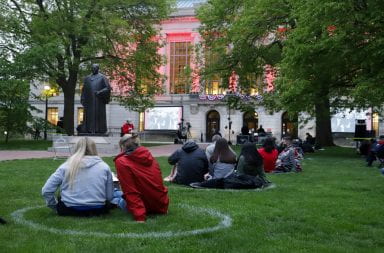As one of the largest public universities in the country, Ohio State is taking steps to be a walking, environmentally consistent campus.
At a Feb. 6 editorial board meeting, President E. Gordon Gee told The Lantern his goals are to develop a small footprint for the university and to have LEED-certified buildings.
“Those (plans) are all very much in place,” Gee said in the meeting.
Some student organizations are taking action to help with these green goals.
Olga Ovchinnikova, president of the Students for a Sustainable Campus, said its main project this quarter is the “Green Buckeye” certification for classrooms.
“This would be a certification for faculty who want to make their classroom experience more sustainable for students by doing things such as limiting printing or encouraging sustainable practices in every day activities,” Ovchinnikova said.
Students can sign the Green Pledge on the organization’s website, and they will then receive monthly tips to help be more green in their everyday life.
“It is a commitment students sign that says they value their relationship with the environment and want to be sustainable in their everyday actions,” Ovchinnikova said.
Campus has already “gone green” in some ways, such as its bicycle storage and focus on transportation alternatives. If walking or biking aren’t practical, the Campus Area Bus Service buses are a viable option, as they are part of the “Scarlet, Gray and Green” initiative and run on biodiesel.
Among the various construction projects taking place on campus, a few are part of the green movement. This can be seen in the narrowing of roads around campus in order to decrease car traffic. Recent construction projects narrowed Woody Hayes Drive and 17th Avenue to make them one lane each way.
“I don’t want to put it by force,” Gee said in the Feb. 6 meeting with The Lantern. “But people are advised to walk a lot more because of the fact that we keep those (roads) narrow.”
Corey Hawkey, OSU sustainability coordinator, said their goal is to increase sustainability of how people commute to campus.
“We want to implement a pedestrian core, a remote parking concept, encourage people to live closer, use buses, bikes and car pool,” Hawkey said.
Transportation is the third largest carbon footprint on campus behind electricity and heating, cooling and steam, Hawkey said.
After investing $2 million in bike culture on campus, and being named a “bike friendly campus,” there are several bicycle conveniences around campus for students to use as an alternative to driving.
Hawkey said the university has increased the bike share on the roads, added signs and reduced the speed limit.
If students still want to drive on campus, they might find it increasingly more difficult.
“We are mixing traffic on the core campus roads to slow down travel — this both makes it safer for pedestrians and bikes and discourages driving,” said Laura Shinn, OSU’s director of planning.
As campus officials are working to limit car traffic on campus, they are also working to give students additional options.
Projects on campus include adding more student housing to increase the number of students living on campus and to decrease the number of commuters, and the “Hertz on Demand” program.
Hertz on Demand is a car-share program that provides rental cars for faculty, staff and students on an hourly basis.
“More students who only need a car occasionally have the security of knowing there is one available,” Shinn said.
As OSU continues to make strides to become more sustainable, it’s important that it remains a community effort, said Tom Koontz, professor of environmental and natural resources policy.
“We need to do a better job of understanding student environmental behaviors and their motivations and constraints,” Koontz said.
The School of Environment and Natural Resources will be conducting a campus-wide survey in March to help aid in this process, Koontz said.
Students can also take classes to increase their understanding of sustainability efforts within different areas of study, Ovchinnikova said.
Sustainability can be part of everyone’s lives with a simple change in routine, Hawkey said.
“The idea is to influence and encourage a culture at the university that recognizes the benefits to being sustainably conscious and using other transportation methods,” Hawkey said.


